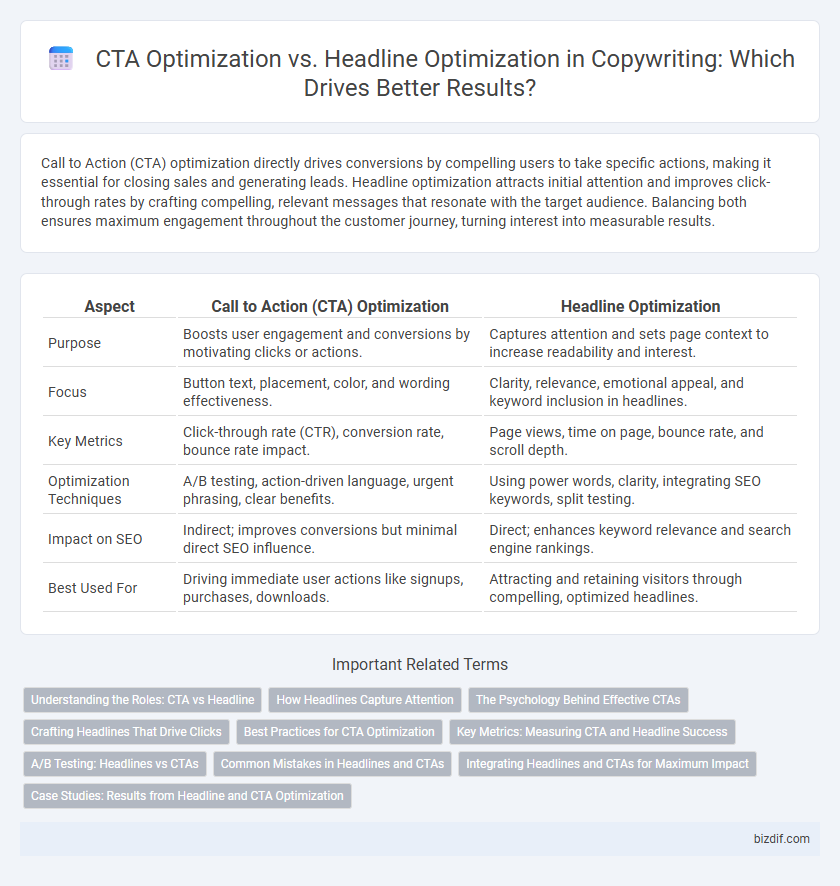Call to Action (CTA) optimization directly drives conversions by compelling users to take specific actions, making it essential for closing sales and generating leads. Headline optimization attracts initial attention and improves click-through rates by crafting compelling, relevant messages that resonate with the target audience. Balancing both ensures maximum engagement throughout the customer journey, turning interest into measurable results.
Table of Comparison
| Aspect | Call to Action (CTA) Optimization | Headline Optimization |
|---|---|---|
| Purpose | Boosts user engagement and conversions by motivating clicks or actions. | Captures attention and sets page context to increase readability and interest. |
| Focus | Button text, placement, color, and wording effectiveness. | Clarity, relevance, emotional appeal, and keyword inclusion in headlines. |
| Key Metrics | Click-through rate (CTR), conversion rate, bounce rate impact. | Page views, time on page, bounce rate, and scroll depth. |
| Optimization Techniques | A/B testing, action-driven language, urgent phrasing, clear benefits. | Using power words, clarity, integrating SEO keywords, split testing. |
| Impact on SEO | Indirect; improves conversions but minimal direct SEO influence. | Direct; enhances keyword relevance and search engine rankings. |
| Best Used For | Driving immediate user actions like signups, purchases, downloads. | Attracting and retaining visitors through compelling, optimized headlines. |
Understanding the Roles: CTA vs Headline
Effective call to action (CTA) optimization directly influences user behavior by guiding prospects toward specific actions such as clicking, subscribing, or purchasing, thus driving conversions. Headline optimization focuses on capturing attention and generating interest by clearly communicating the value proposition and attracting the target audience. Understanding the distinct roles of CTAs and headlines enables marketers to design compelling copy that maximizes engagement and converts traffic into measurable results.
How Headlines Capture Attention
Headlines capture attention by instantly conveying the core message with compelling and relevant keywords, maximizing click-through rates. Effective headline optimization leverages emotional triggers and clarity to engage readers before they encounter the Call to Action (CTA). While CTA optimization drives conversions, headlines are essential for attracting initial interest and encouraging further interaction.
The Psychology Behind Effective CTAs
Effective CTAs leverage psychological triggers such as urgency, scarcity, and social proof to motivate immediate action, making them a critical component in conversion-focused copywriting. Unlike headlines that primarily capture attention, optimized CTAs tap into the user's decision-making processes by emphasizing benefits and clear next steps. Understanding cognitive biases and emotional drivers enhances CTA performance, driving higher engagement and maximizing conversion rates.
Crafting Headlines That Drive Clicks
Crafting headlines that drive clicks involves leveraging persuasive language, emotional triggers, and clear value propositions to grab attention instantly. Optimizing headlines enhances click-through rates by appealing directly to audience intent and search intent relevance, outperforming mere call to action tweaks. Data shows that strong headline optimization can increase engagement by up to 50%, making it the cornerstone of effective copywriting strategies.
Best Practices for CTA Optimization
Effective CTA optimization involves crafting concise, action-oriented language that creates urgency and clearly communicates the value proposition to increase conversion rates. Utilizing A/B testing to compare different CTA texts, colors, and placements helps identify the most impactful combinations tailored to target audiences. Incorporating strong verbs, personalized messaging, and visually distinct buttons aligned with user intent significantly enhances engagement and drives desired actions.
Key Metrics: Measuring CTA and Headline Success
CTA optimization significantly impacts conversion rates by encouraging user interactions through persuasive language and strategic placement, while headline optimization primarily drives click-through rates by capturing attention and generating interest. Measuring CTA success involves tracking metrics such as conversion rate, click-through rate, and user engagement on the landing page, whereas headline effectiveness is evaluated by analyzing click-through rates, bounce rates, and time spent on the page. Balancing both elements with A/B testing and heatmaps ensures comprehensive improvements in user behavior and ROI.
A/B Testing: Headlines vs CTAs
A/B testing headlines and CTAs reveals distinct impacts on conversion rates, with headlines influencing initial engagement and CTAs driving final actions. Optimizing headlines enhances user interest and click-through rates, while refining CTAs directly improves conversion and user decision-making. Data-driven analysis of A/B tests allows marketers to prioritize changes based on measurable lift in performance metrics for each element.
Common Mistakes in Headlines and CTAs
Common mistakes in headline optimization include vague language, lack of clarity, and neglecting keyword relevance, which reduce engagement and search visibility. In CTA optimization, errors such as weak verbs, unclear benefits, and poor placement lead to lower conversion rates and missed opportunities for user action. Focusing on precise, compelling headlines and action-driven CTAs is crucial for maximizing click-through and conversion performance.
Integrating Headlines and CTAs for Maximum Impact
Integrating headlines and call to action (CTA) elements strategically enhances user engagement by creating a seamless narrative that drives conversions. Effective CTA optimization aligns with headline messaging to reinforce the core value proposition, increasing click-through rates and reducing bounce rates. Data-driven approaches, such as A/B testing combined with semantic relevance analysis, ensure that both headlines and CTAs are contextually compelling and tailored to target audience intent for maximum marketing impact.
Case Studies: Results from Headline and CTA Optimization
Case studies reveal that CTA optimization often drives higher conversion rates than headline tweaks by creating clear, action-oriented prompts tailored to audience behavior. In contrast, headline optimization boosts initial engagement and click-through rates by capturing attention with compelling value propositions and emotional triggers. Combining insights from both approaches yields a balanced strategy that maximizes traffic and converts visitors effectively.
Call to Action (CTA) Optimization vs Headline Optimization Infographic

 bizdif.com
bizdif.com